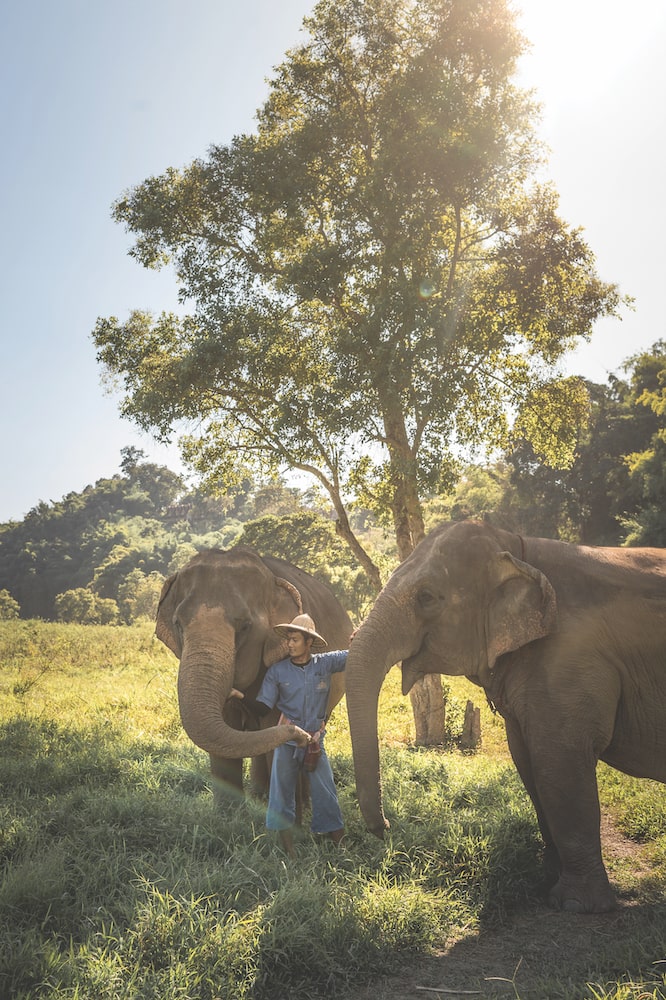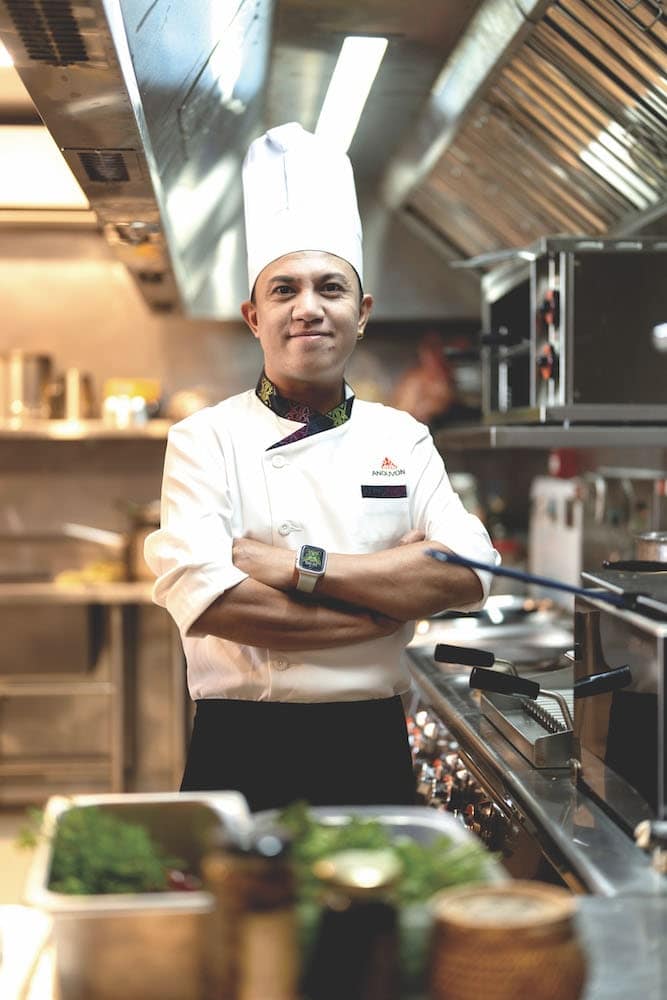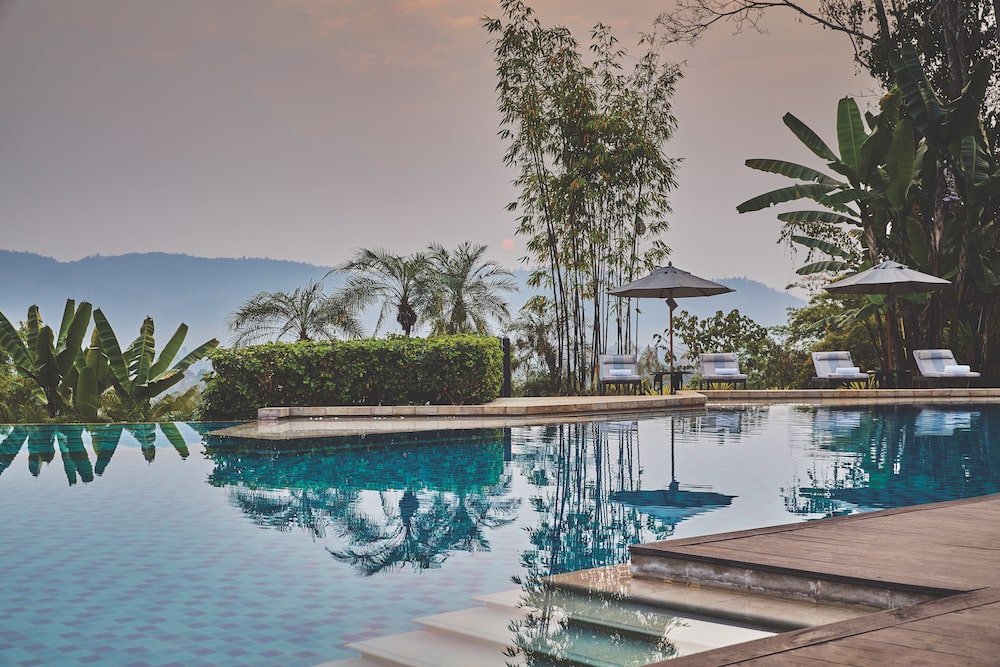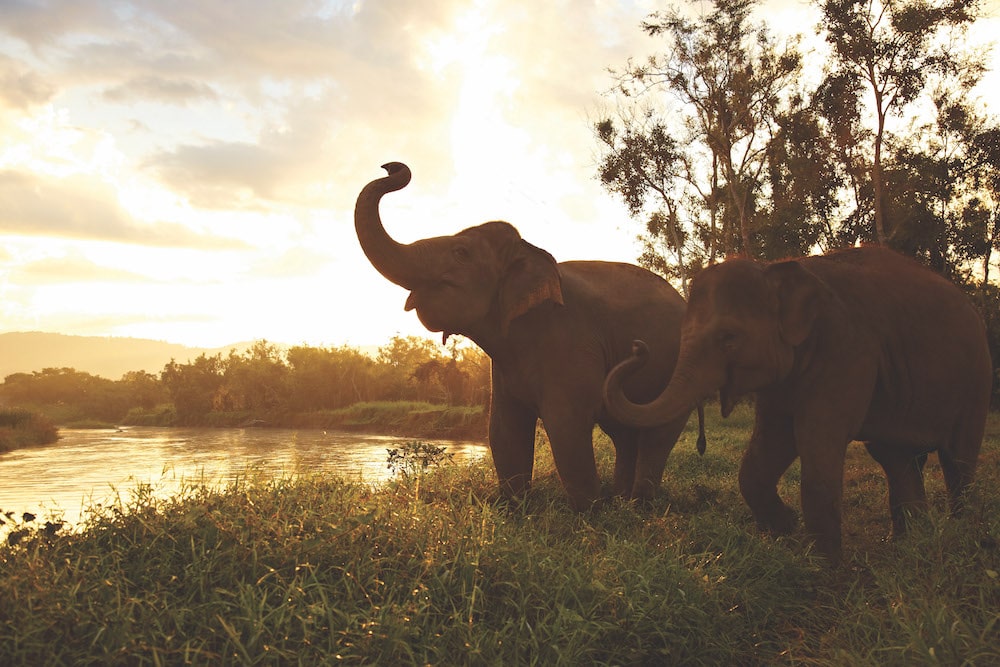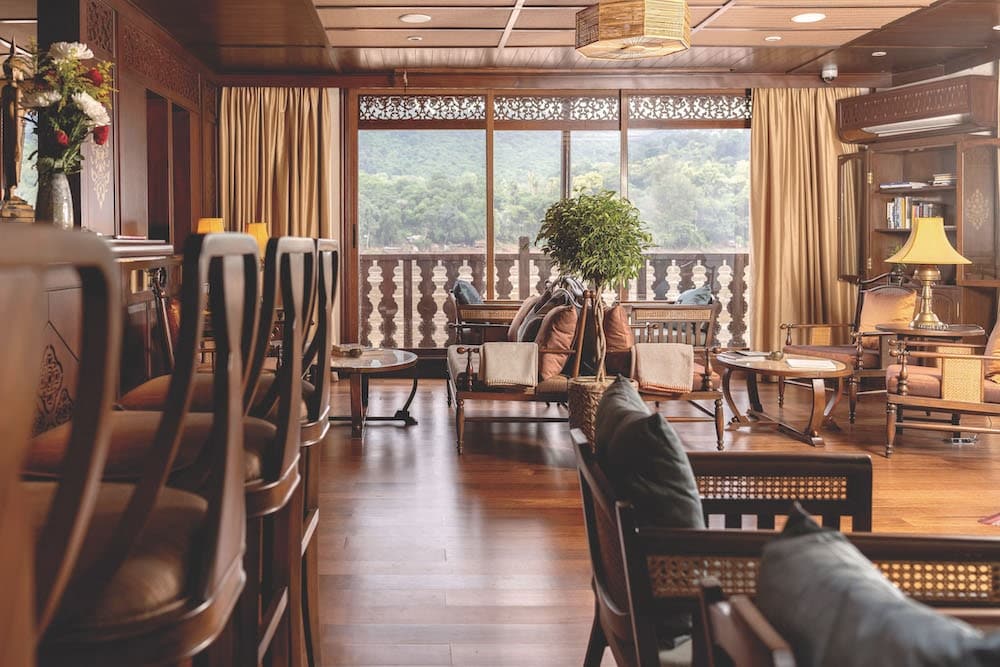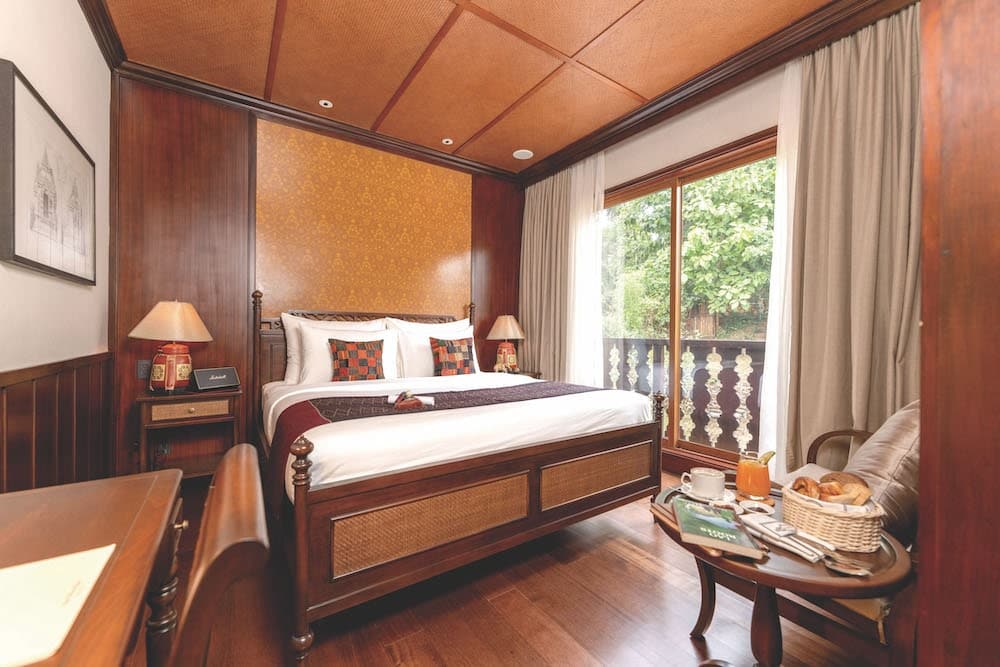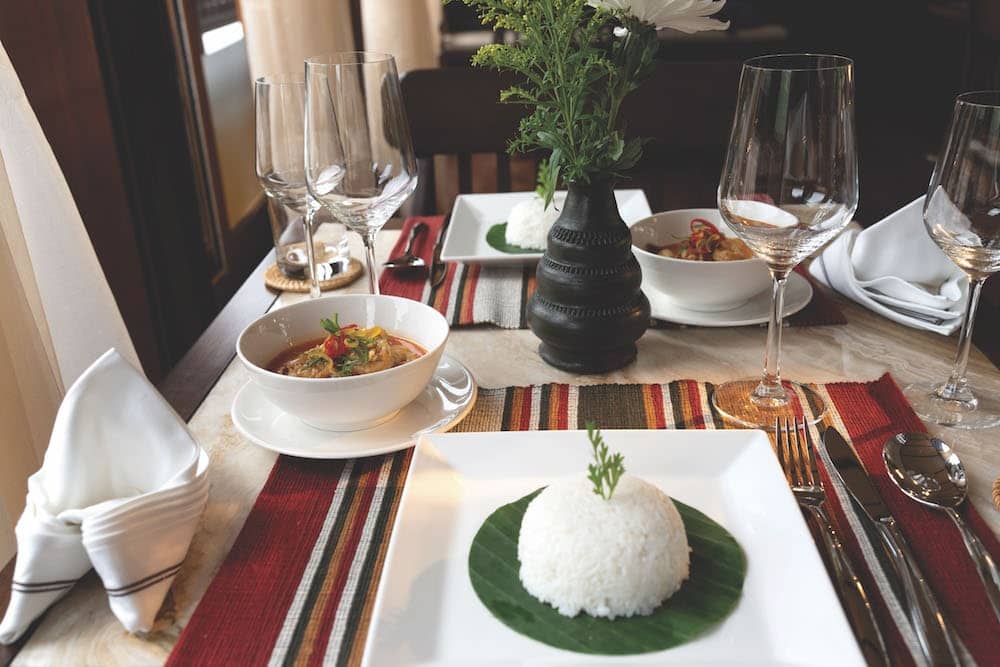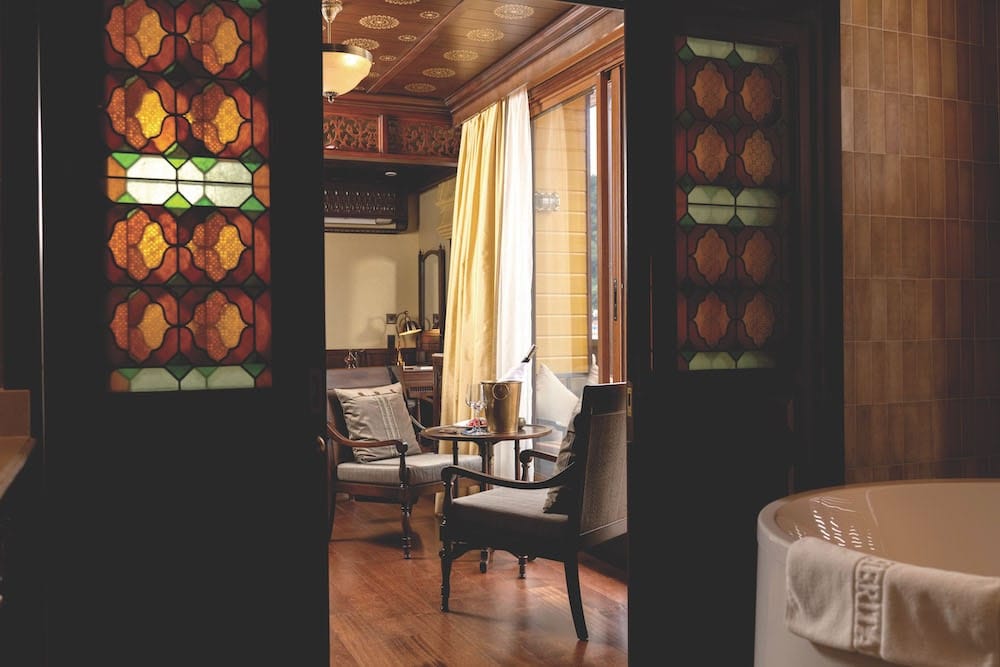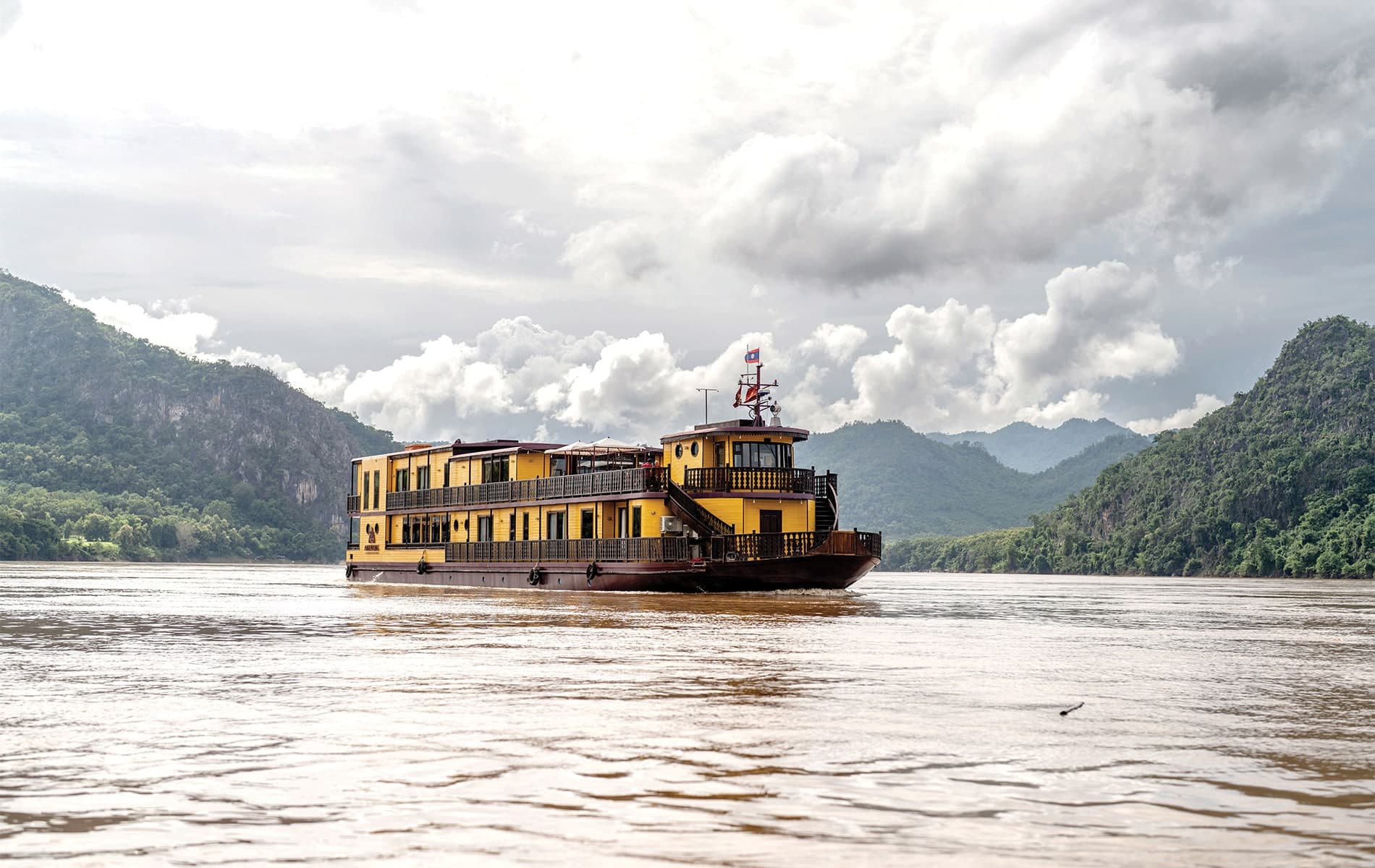
vie-magazine-laos-thailand-river-cruise-hero-min
Heritage Line’s handcrafted Anouvong luxury cruise ship was named after the last monarch of the Kingdom of Vientiane, who ruled from 1805 to 1812 and led the Lao rebellion. | Photo courtesy of Heritage Line
Going with the Flow
A Mekong River Odyssey
By Sarah Freeman
A journey from Thailand’s mountainous north to the ancient royal capital of Laos proves to be equal parts edifying and enchanting.
Another branch crackles under fifty-eight-year-old Boonma’s three-ton frame as she edges towards the rushing river, with baby Chok Petch following excitably in her adopted grandma’s muddy footprints. Following these altruistic animals at a respectful distance, I traverse from a rice field to a floodplain as their mahouts (elephant caretakers) escort them through bamboo thickets.
“Walking with Giants” is just one of the ethical elephant-centric activities guests at Anantara Golden Triangle Resort, located in Thailand’s northernmost province of Chiang Rai, can experience during their stay. Nestled on a wooded ridge overlooking the Mekong and Ruak Rivers, the hotel doubles as an award-winning elephant camp operated in partnership with the Golden Triangle Asian Elephant Foundation (GTAEF). Twenty Asian elephants live out a peaceful existence here after decades spent working in Thailand’s (now outlawed) logging industry or as street-begging pachyderms. “Chok Petch’s ribs were visible when he first came to us,” veterinarian Nissa Mututanont reveals as we watch the calf noisily chow down on fresh sugarcane.
The hotel’s muse, these peaceful pachyderms grace everything from the bedrooms’ ornate television surrounds to the table runners in its indoor-outdoor restaurant, Sala Mae Nam, where I find myself later that evening. I slurp up a Laotian ruby fish sour soup followed by Burmese curried coconut noodles from Laos’s neighbor Myanmar, both of which converge with Thailand to form the “Golden Triangle.” As for the menu’s homegrown ingredients, many hail from the country’s philanthropic Royal Project. Founded by Thailand’s longest reigning monarch, it was established in 1969 to incentivize impoverished hill tribe farmers to swap opium poppy-growing for alternative cash crops like organic coffee and salad greens.
The restaurant’s tri-country vistas follow me around the resort, as I enjoy them first from its glass-walled spa and sweeping infinity pool, then from my room’s balcony daybed. With a deep terrazzo tub to soak in and a choice of seven pillows to nod off with, the teakwood-floored Three Country View Suite is primed for uninterrupted sleep—even if the camp’s trumpeting elephants have other ideas!
Several days later, I find myself on another hands-off (meaning no bathing, feeding, or riding) but heartening jumbo experience, this time in landlocked Laos, formerly Lan Xang or “Land of a Million Elephants.” Whittled down to just eight hundred, the country’s fragile population relies more than ever on ethically run sanctuaries like the Mekong Elephant Park (MEP) in Pakbeng. It marks the halfway point of a newly launched four-day Mekong River cruise, which journeys 185 miles downstream from the Thai-Laos border town of Huay Xai to Laos’s former royal capital of Luang Prabang.
I soon discover signs of civilization are satisfyingly scarce on the Upper Mekong’s narrower meandering course. River traffic amounts to canoe-paddling fishermen and longboat taxis ferrying villagers across the fabled waterway. The floor-to-ceiling windows of our boutique boat’s café-bar-lounge frame the timeless riverscape of vertiginous rice fields, grazing water buffalo, and stilted homes. Named after the last king of Lan Xang, Heritage Line’s French-balconied, twenty-passenger vessel—outfitted with two signature suites and eight staterooms—made her maiden voyage in August. Hand-built not in some soulless shipyard but on the life-nurturing banks of the mighty Mekong, Anouvong reflects its surroundings. Think framed antique Laotian jewelry, stenciled ceilings inspired by Luang Prabang’s temple art, and black-and-white portraits of monks, whom I see in all their marigold-robed glory over the coming days.
Blessings aren’t just reserved for practicing Buddhists. The cruise commences with a traditional baci (good luck ceremony) led by a chanting village elder in Ban Khon Teun. Only accessible by water, this remote riverside community is one of a handful visited on the culturally immersive voyage, steered by onboard guide Khankeo Bidarvong. A fount of knowledge on Laos’s ethnic groups, the former monk also hosts sunrise Tai Chi from Anouvong’s terrace deck, reimagined as a cinema one night and a floating stage for traditional dance the next.
Hand-built not in some soulless shipyard but on the life-nurturing banks of the mighty Mekong, Anouvong reflects its surroundings.
In a departure from Chef Tee’s four-course Lao-Thai meals served in the lower deck’s French-colonial-styled Delaporte Dining Lounge, our last supper unfolds on a lantern-lit sandbar. I join other barefooted passengers in padding across a homespun bamboo pier for a BBQ buffet fit for Laotian royalty.
Nowhere does the Mekong’s unique geology intersect more tangibly with spirituality than at Pak Ou Caves. Our final port of call, this centuries-old pilgrimage site is just fifteen miles upstream from UNESCO-crowned Luang Prabang. Cut dramatically into a limestone cliff face, the two caves’ interiors are strewn with four thousand Buddha statues ranging from a few centimeters to two meters tall! Emerging to daylight once more, our group raises a collective glass to the cruise at a nearby community-run craft whiskey distillery, where we’re served colorless shots of Lao-Lao made from the country’s famous sticky rice.
Several of the ubiquitous grain’s three thousand varieties are harvested from the emerald green rice paddies surrounding me at a not-for-profit organic farm on the outskirts of Luang Prabang. Framed by jungle-clad hills, it makes a bucolic backdrop for enjoying an alfresco cooking class led by Chef Nilanoud from Amantaka, aka Luang Prabang’s foremost five-star hotel. In two toothsome hours, I create (and consume!) a green papaya salad, banana leaf steamed fish, and stir-fried lemongrass pork. The two-part edible excursion began with an early morning city market crawl along an alley where Mekong farmers have peddled their produce, like palm-sized figs and nori-like riverweed, for generations.
Back at my blissful basecamp, I counter the afternoon humidity with a post-lunchtime dip in Amantaka’s twenty-six-meter-long pool, where ruby-red dragonflies dance above my head. The terracotta-roofed hotel’s centerpiece, the pool nestles in manicured gardens skirted by twenty-four single-storied, pistachio-shuttered suites. Understated and uncluttered, my ceramic tiled room is furnished with a teak chaise lounge, classic writing bureau, and four-poster bed that reaches for the vaulted ceiling. Also worthy of mention is the clawfoot bath that overlooks my sun-dappled courtyard patio.
It doesn’t take long for the suite’s zen-like atmosphere to rub off on me. I practically float to the hotel’s monastically quiet bathhouse, where I sauna, steam, cold plunge, and repeat before having every irksome knot melted away by the spa’s signature holistic massage. Rejuvenated, I dine on dishes inspired by recipes from the Lao royal court at Amantaka’s colonial-era dining room.
The following morning, I’m whisked off in one of the hotel’s stylish cream-leather-seated tuk-tuks for one final edifying excursion that’s been tailor-made by Amantaka. “He was a brave king!” local guide Siththai Sayasone says as we marvel at the ornate elephant carriage that Anouvong—who ruled from 1805 to 1828—rode into battle on. It’s just one of the eight thousand artifacts displayed at the city’s celebrated National Museum, a retired royal residence just across the road from Mount Phousi. It is Luang Prabang’s loftiest eyrie, and scores of visitors make the 355-step pilgrimage to its summit temple at sunset. But Sayasone has his sights on another of the city’s wats (temples): Xieng Thong, which dazzles with mosaicked walls and mirrored elephant heads. Scenically set on Luang Prabang’s sacred peninsula, it sits at the confluence of the Mekong and Nam Khan Rivers, where my watery voyage of discovery comes to a close.
— V —
Anantara Golden Triangle Resort is one hour from Thailand’s Chiang Rai International Airport. The property’s Golden Triangle Luxury Explorer Package (starting from $1,150 per night) includes full board, one hotel activity per day, a sixty-minute spa treatment, a private yoga class, and roundtrip airport transfers. See Anantara.com for more details.
Heritage Line’s four-day Huay Xai to Luang Prabang (or vice versa) river cruise aboard Anouvong starts at $2,800 per person (staying in a deluxe stateroom), including all meals, excursions, and entrance fees. For more information, see Heritage-Line.com.
A stay at Luang Prabang’s Amantaka starts from $1,250 per night, including roundtrip airport transfers, daily breakfast, afternoon tea, a choice of lunch or dinner, and use of the bathhouse. The hotel is a ten-minute drive from Laos’s Luang Prabang International Airport. Visit Aman.com to book.
Share This Story!
KEEP UP WITH THE LATEST STORIES FROM VIE



